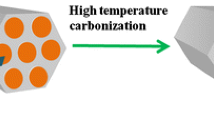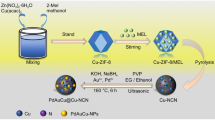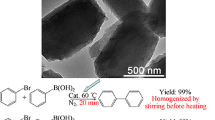Abstract
N-doped ordered mesoporous carbons (NCMK-3) were synthesized using urea and ammonia as nitrogen sources via an incipient wetness impregnation method. To quantify the amount of nitrogen doping and classify the nitrogen bond formations, the XPS technique was used in this study. It was found that urea can increase the nitrogen content up to 2.54% and can classify nitrogen on NCMK-3 into three types: pyridinic-N, pyrrolic-N, and graphitic-N. Subsequently, 15 wt% of Cu–ZnO and 15 wt% of Cu–CeO2 were loaded on NCMK-3 and tested for methanol production from the CO2 hydrogenation reaction. The catalysts’ performance was evaluated in a fixed-bed reactor using 0.25 g of catalyst and a CO2/H2 (1/3) mixture at GHSV of 2444 h−1. The results showed that 15 wt% of Cu–ZnO on the nitrogen-doped CMK-3 using urea as a nitrogen source (CZ/NCMK-3U) provided the highest space time yield (STY) of 512 mgMeOH gcat−1 h−1 at the reaction temperature and pressure of 250 °C and 1.5 MPa, respectively.

















Similar content being viewed by others
Data Availability
The data used to support the findings of this study are available from the corresponding author upon request.
References
Álvarez A, Bansode A, Urakawa A, Bavykina AV, Wezendonk TA, Makkee M, Gascon J, Kapteijn F (2017) Challenges in the greener production of formates/formic acid, methanol, and DME by heterogeneously catalyzed CO2 hydrogenation processes. Chem Rev 117(14):9804–9838
Banerjee A, Dick GR, Yoshino T, Kanan MW (2016) Carbon dioxide utilization via carbonate-promoted C–H carboxylation. Nature 531(7593):215–219
Wang J, Zhang G, Zhu J, Zhang X, Ding F, Zhang A, Song C (2021) CO2 hydrogenation to methanol over In2O3-based catalysts: from mechanism to catalyst development. ACS Catal 11:1406–1423
Abdelmoaty YH, Tessema TD, Norouzi N, El-Kadri OM, Turner JB, El-Kaderi HM (2017) Effective approach for increasing the heteroatom doping levels of porous carbons for superior CO2 capture and separation performance. ACS Appl Mater Interfaces 9(41):35802–35810
Wang W, Wang S, Ma X, Gong J (2011) Recent advances in catalytic hydrogenation of carbon dioxide. Chem Soc Rev 40(7):3703–3727
Jadhav SG, Vaidya PD, Bhanage BM, Joshi JB (2014) Catalytic carbon dioxide hydrogenation to methanol: a review of recent studies. Chem Eng Res Des 92(11):2557–2567
Yang H, Zhang C, Gao P, Wang H, Li X, Zhong L, Wei W, Sun Y (2017) A review of the catalytic hydrogenation of carbon dioxide into value-added hydrocarbons. Catal Sci Technol 7(20):4580–4598
Parapat RY, Saputra OH, Ang AP, Schwarze M, Schomäcker R (2014) Support effect in the preparation of supported metal catalysts via microemulsion. RSC Adv 4(92):50955–50963
Huwe H, Fröba M (2007) Synthesis and characterization of transition metal and metal oxide nanoparticles inside mesoporous carbon CMK-3. Carbon 45(2):304–314
Olchowski R, Dobrowolski R (2019) Synthesis, properties and applications of CMK-3-type ordered mesoporous carbons. Annales Universitatis Mariae Curie-Sklodowska Sectio AA Chemia 73(1):11–30
Deerattrakul V, Yigit N, Rupprechter G, Kongkachuichay P (2019) The roles of nitrogen species on graphene aerogel supported Cu–Zn as efficient catalysts for CO2 hydrogenation to methanol. Appl Catal A Gen 580:46–52
Zhao D, Feng J, Huo Q, Melosh N, Fredrickson GH, Chmelka BF, Stucky GD (1998) Triblock copolymer syntheses of mesoporous silica with periodic 50 to 300 angstrom pores. Science 279(5350):548–552
Pimprom S, Sriboonkham K, Dittanet P, Föttinger K, Rupprechter G, Kongkachuichay P (2015) Synthesis of copper-nickel/SBA-15 from rice husk ash catalyst for dimethyl carbonate production from methanol and carbon dioxide. J Ind Eng Chem 31:156–166
Zeng J, Francia C, Dumitrescu MA, Monteverde Videla AH, Ijeri VS, Specchia S, Spinelli P (2012) Electrochemical performance of Pt-based catalysts supported on different ordered mesoporous carbons (Pt/OMCs) for oxygen reduction reaction. Ind Eng Chem Res 51(22):7500–7509
Yao C, Wang M, Jiang W, Chen Y (2021) Study on a novel N-doped mesoporous carbon for the efficient removal of methylene blue from aqueous solution. Environ Eng Res 26(5):200339
Deerattrakul V, Dittanet P, Sawangphruk M, Kongkachuichay P (2016) CO2 hydrogenation to methanol using Cu–Zn catalyst supported on reduced graphene oxide nanosheets. J CO2 Util 16:104–113
Costa MB, Juárez JM, Anunziata OA (2016). In: Dariani RS (ed) Microporous mesoporous materials. IntechOpen, London. https://doi.org/10.5772/63710
Juárez JM, Ledesma BC, Gómez Costa M, Beltramone AR, Anunziata OA (2017) Microporous Mesoporous Mater 254:146–152
Fang J, Xuan Y (2017) Investigation of optical absorption and photothermal conversion characteristics of binary CuO/ZnO nanofluids. RSC Adv 7(88):56023–56033
Kerkar RD, Salker AV (2020) A route to develop the synergy between CeO2 and CuO for low temperature CO oxidation. Catal Lett 150:2774–2783
Fan W, Miao YE, Huang Y, Tjiu WW, Liu T (2015) Flexible free-standing 3D porous N-doped graphene–carbon nanotube hybrid paper for high-performance supercapacitors. RSC Adv 5(12):9228–9236
Ranganathan K, Morais A, Nongwe I, Longo C, Nogueira AF, Coville NJ (2016) Study of photoelectrochemical water splitting using composite films based on TiO2 nanoparticles and nitrogen or boron doped hollow carbon spheres as photoanodes. J Mol Catal A Chem 422:165–174
Kumar P, Mungse HP, Khatri OP, Jain SL (2015) Nitrogen-doped graphene-supported copper complex: a novel photocatalyst for CO2 reduction under visible light irradiation. RSC Adv 5(68):54929–54935
Wang Q, Wang Z, Zheng T, Zhou X, Chen W, Ma D, Yang Y, Huang S (2016) Size control of SBA-15 by tuning the stirring speed for the formation of CMK-3 with distinct adsorption performance. Nano Res 9:2294–2302
Jun S, Joo SH, Ryoo R, Kruk M, Jaroniec M, Liu Z, Ohsuna T, Terasaki O (2000) Synthesis of new, nanoporous carbon with hexagonally ordered mesostructure. J Am Chem Soc 122(43):10712–10713
Huo J, Tessonnier JP, Shanks BH (2021) Improving hydrothermal stability of supported metal catalysts for biomass conversions: a review. ACS Catal 11(9):5248–5270
Zhao Y, Dong F, Han W, Zhao H, Tang Z (2018) Construction of Cu–Ce/graphene catalysts via a one-step hydrothermal method and their excellent CO catalytic oxidation performance. RSC Adv 8(3):1583–1592
Zhu J, Ciolca D, Liu L, Parastaev A, Kosinov N, Hensen EJ (2021) Flame synthesis of Cu/ZnO–CeO2 catalysts: synergistic metal-support interactions promote CH3OH selectivity in CO2 hydrogenation. ACS Catal 11(8):4880–4892
Arena F, Italiano G, Barbera K, Bordiga S, Bonura G, Spadaro L, Frusteri F (2008) Solid-state interactions, adsorption sites and functionality of Cu–Zno/ZrO2 catalysts in the CO2 hydrogenation to CH3OH. Appl Catal A Gen 350:16–23
Xie S, Zhang W, Lan X, Lin H (2020) CO2 reduction to methanol in the liquid phase: a review. Chemsuschem 13(23):6141–6159
Deerattrakul V, Chukchuan A, Thepphankulngarm N, Pornjaturawit J, Vacharameteevoranun N, Chaisuwan T, Kongkachuichay P (2021) Carbon dioxide hydrogenation to methanol over polybenzoxazine-based mesocarbon supported Cu–Zn catalyst. New J Chem 45(18):8283–8290
Luo Z, Tian S, Wang Z (2020) Enhanced activity of Cu/ZnO/C catalysts prepared by cold plasma for CO2 hydrogenation to methanol. Ind Eng Chem Res 59(13):5657–5663
Wang G, Chen L, Sun Y, Wu J, Fu M, Ye D (2015) Carbon dioxide hydrogenation to methanol over Cu/ZrO2/CNTs: effect of carbon surface chemistry. RSC Adv 5(56):45320–45330
Acknowledgements
This research was supported in part by the National Nanotechnology Center (NANOTEC), NSTDA, Ministry of Higher Education, Science, Research, and Innovation, through its program of Research Network of NANOTEC (RNN) and the Kasetsart University Research and Development Institute (KURDI).
Author information
Authors and Affiliations
Contributions
Conceptualization: PK; Methodology: PK, PL; Formal analysis and investigation: AC, NT, PK, PL, Writing—original draft preparation: AC, NT; Writing—review and editing: PK, PL; Funding acquisition: PK; Supervision: PK.
Corresponding author
Additional information
Publisher's Note
Springer Nature remains neutral with regard to jurisdictional claims in published maps and institutional affiliations.
Rights and permissions
Springer Nature or its licensor (e.g. a society or other partner) holds exclusive rights to this article under a publishing agreement with the author(s) or other rightsholder(s); author self-archiving of the accepted manuscript version of this article is solely governed by the terms of such publishing agreement and applicable law.
About this article
Cite this article
Limleamthong, P., Chuchuan, A., Thepphankulngarm, N. et al. Structured Porous Carbon-Based Catalysts: Cu–ZnO/CMK-3 and Cu–CeO2/CMK-3 for Direct CO2 Conversion to Methanol. Top Catal 66, 1515–1526 (2023). https://doi.org/10.1007/s11244-023-01811-w
Accepted:
Published:
Issue Date:
DOI: https://doi.org/10.1007/s11244-023-01811-w




